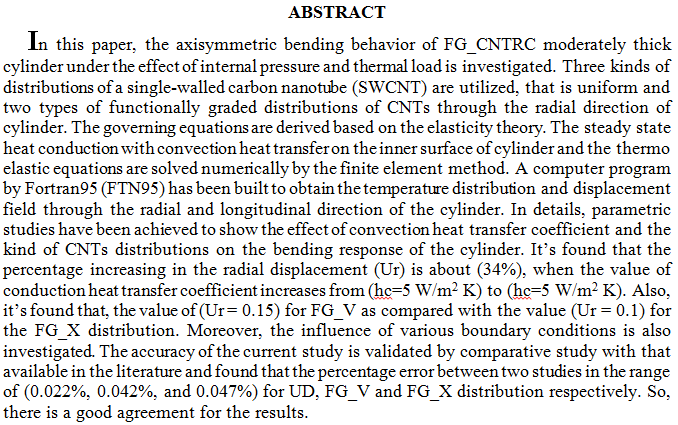
Investigation of the adsorption of Chromium (VI) on Fe3O4 is carried out using batch scale experiments according to statistical design using a software program minitab17 (Box-Behnken design). Experiments were carried out as per Box-Behnken design with four input parameters such as pH (2-8), initial concentration (50–150mg/L), adsorbent dosage (0.05–0.3 g) and time of adsorption (10–60min). The better conditions were showed at pH: 2; contact time: 60 min; chromium concentration: 50 mg/L and magnetite dosage: 0.3 g for maximum Chromium (VI) removal of (98.95%) with an error of 1.08%. The three models (Freundlich, Langmuir, and Temkin) were fitted to experimental data, Langmuir isotherm has bette
... Show MoreGeography of industry has been considered a branch of important economic geographical branches. This importance has been regarded as a reflection on the industrial sector contribution in economies of any state since they contribute into the total national product ; it also assimilates a huge number of labor hands . The industry of grains grinding has been considered as one of the main food industries having a main role in satisfying the need of the population from the foods. The industry is continued to use the food as daily meal . Here, it should predict the population in Baghdad and for every district until the end of 2025 and knowing either these grains grinders are able to meet and satisfy the needs of populations of flours, making s
... Show MoreIn this work, yttrium oxide particles (powder) reinforced AL-Si matrix composites (Y2O3/Al-Si) and Chromium oxide particles reinforced AL-Si matrix composites (Cr2O3/AL-Si) were prepared by direct squeeze casting. The volume percentages of yttrium oxide used are (4, 8.1, 12.1, 16.1 vol %) and the volume percentages of the chromium oxide particles used are (3.1, 6.3, 9.4, 12.5 vol. %). The parameters affecting the preparation of Y2O3/Al-Si and Cr2O3/AL-Si composites by direct squeeze casting process were studied. The molten Al-Si alloy with yttrium oxide particles or with chromium oxide particles was stirred again using an electrical stirrer at speed 500 rpm and the molten alloy was poured into the squeeze die cavity. Th
... Show MoreExistence of these soils, sometimes with high gypsum content, caused difficult problems to the buildings and strategic projects due to dissolution and leaching of gypsum by the action of waterflow through soil mass. In this research, a new technique is adopted to investigate the performance of replacement and geosynthetic reinforcement materials to improve the gypseous soil behavior through experimential set up manufactured loaclally specially for this work. A series of tests were carried out using steel container (600*600*500) mm. A square footing (100*100) mm was placed at the center of the top surface of the bed soil. The results showed that the most effective thickness for the dune sand layer with geotextile at the interface, within
... Show More (8)
(8)
For more than a decade, externally bonded carbon fiber reinforced polymer (CFRP) composites successfully utilized in retrofitting reinforced concrete structural elements. The function of CFRP reinforcement in increasing the ductility of reinforced concrete (RC) beam is essential in such members. Flexural and shear behaviors, ductility, and confinement were the main studied properties that used the CFRP as a strengthening material. However, limited attention has been paid to investigate the energy absorption of torsion strengthening of concrete members, especially two-span concrete beams. Hence, the target of this work is to investigate the effectiveness of CFRP-strengthening technique with regard to energy absorption of two-span RC
... Show More (23)
(23)
 (18)
(18)
This research presents and discuss the results of experimental investigation carried out on geogrids model to study the behavior of geogrid in the loose sandy soil. The effect of location eccentricity, depth of first layer of reinforcement, vertical spacing, number and type of reinforcement layers have been investigated. The results indicated that the percentage of bearing improvement a bout (22 %) at number of reinforced layers N=1 and about (47.5%) at number of reinforced layers N=2 for different Eccentricity values when depth ratio and vertical spacing between layers are (0.5B and 0.75B) respectively
 (10)
(10)
 (6)
(6)
This paper studies the behavior of reinforced Reactive Powder Concrete (RPC) two-way slabs under static and repeated load. The experimental program included testing six simply supported RPC two-way slabs of 1000 mm length, 1000 mm width, and 70 mm thickness. All the tested specimens were identical in their material properties, and reinforcement details except their steel fibers content. They were cast in three pairs, each one had a different steel fibers ratio (0.5 %, 1 %, and 1.5 %) respectively. In each pair, one specimen was tested under static load and the other under five cycles of repeated load (loading-unloading). Static test results revealed that increasing steel fibres volume fraction from 0.5 % to 1 % and from 1% to 1.5%,
... Show More (12)
(12)
A theoretical and protection study was conducted of the corrosion behavior of carbon steel surface with different concentrations of the derivative (Quinolin-2-one), namly (1-Amino-4,7-dimethyl-6-nitro-1H-quinolin-2-one (ADNQ2O)). Theoretically, Density Functional Theory (DFT) of B3LYP/ 6-311++G (2d, 2p) level was used to calculate the optimized geometry, physical properties and chemical inhibition parameters, with the local reactivity to predict both the reactive centers and to locate the possible sites of nucleophilic and electrophilic attacks, in vacuum, and in two solvents (DMSO and H2O), all at the equilibrium geometry. Experimentally, the inhibition efficiencies (%IE) in the saline solution (of 3.5%) NaCl were st
... Show More (23)
(23)
 (6)
(6)
